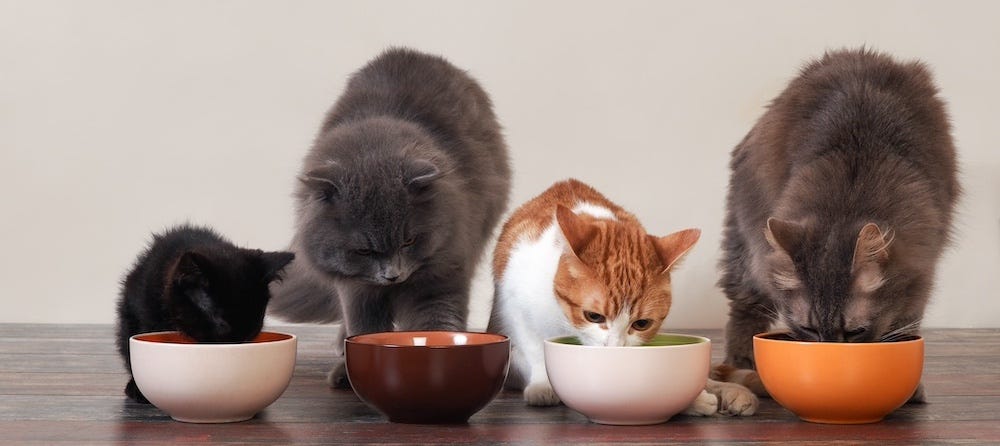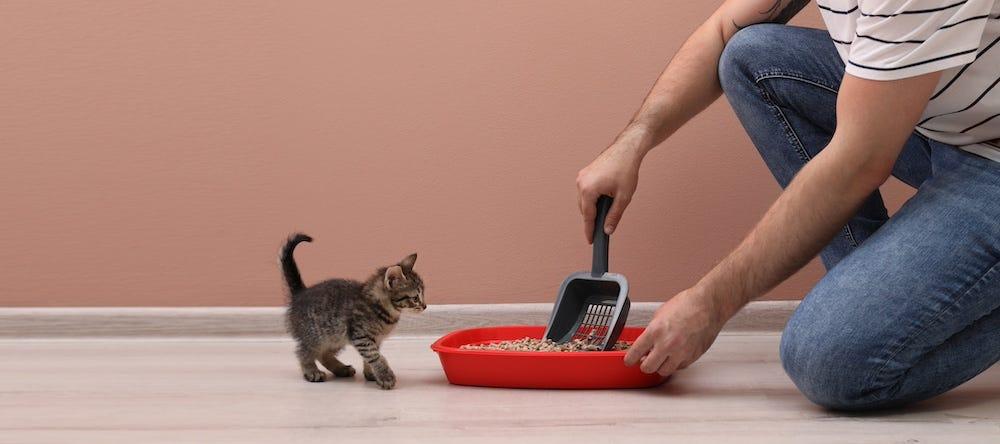Last month, I reviewed what you need to know about diabetes mellitus in cats, including symptoms and diagnosis. Now it’s time to learn how to treat diabetes in cats. If your cat was just diagnosed with diabetes mellitus, it can seem scary to give him an injection twice a day (yes, twice!). However, I promise that once you get used to it, the treatment isn’t too difficult!
In today’s post, I’ll explain how we veterinary professionals treat cats with diabetes mellitus. If you haven’t read part 1, make sure to check out that blog post first. Also, make sure to learn the key words and abbreviations listed below, as it’ll help you understand common terms used by your veterinary team, specific to diabetes.
How to treat diabetes in cats
Earlier, we talked about how when cats develop diabetes, they often get Type II diabetes mellitus. This means the diabetes may be transient. Because of this, we can try initial treatments that are less invasive than injections of insulin. This may include oral medications, dietary changes, and weight loss. Oral medications include “hypoglycemic medications” like glipizide, which attempt to lower blood sugar. Dietary changes include a low-carbohydrate, high-protein diet (similar to Purina DM™ or canned kitten food). For obese or overweight cats, weight loss is imperative to help regulate DM. If your cat fails to respond to these initial treatments (in other words, they have a persistently elevated blood sugar and still have clinical signs of excessive urination, thirst, etc.), twice-a-day insulin therapy is typically necessary. When we talk about how to treat diabetes in cats, it often ends up being a case of insulin therapy.
Giving insulin
So, if your veterinarian just told you that you have to give injections, what do you need to know? While giving insulin injections may sound intimidating, cat owners typically feel very comfortable with it quickly. Once your veterinarian shows you how to do so, it’s easy, as the needle size is minuscule! When in doubt, ask your veterinary professional to shave a small area over the neck so you can see where you are injecting—this helps!
Types of insulin
Keep in mind that there are several types of insulin out there—either human or veterinary types. The different types of insulin used in cats include:
- Insulin glargine (e.g., Lantus)
- Detemir (e.g., Levemir)
- Lente (e.g., Vetsulin)
- NPH (e.g., Humulin-N, Novolin N)
- Protamine zinc (PZI)
It’s important to know the exact type of insulin that you are using, as each type of insulin requires a specific type of insulin syringe. When in doubt, always confirm with your veterinarian, as human pharmacists may not prescribe you the correct type. All human-specific insulins (e.g., detemir, glargine, NPH) must be given with the U-100 syringe, versus veterinary-specific insulin (e.g., PZI, lente) that must be given with a U-40 syringe. Note that a U-100 syringe (which usually has an orange cap) measures out 100 units of insulin per mL, while a U-40 syringe (which usually has a red cap) measures out 40 units of insulin per mL. This means that “one unit” is a different amount/volume depending on which syringe you use!
Dosage
Depending on the type of insulin your veterinarian recommends, we’ll have to start your cat on a very low dose of insulin (often just 1 unit every 12 hours). Gradually, we’ll increase this amount, depending on how your cat is responding to therapy. The reason why we can’t just reach for a higher amount of insulin initially is it can cause life-threateningly low blood sugar (a “hypoglycemia”). This is another reason why if your cat isn’t eating, we want to hold off on the insulin dose, as it can cause hypoglycemia. If you ever notice signs such as weakness, vomiting, not moving, hiding, tremors, or seizures, get to a veterinarian immediately—even in the middle of the night!
Follow-up
Once you start your cat on insulin, you’ll need to follow up closely with your veterinarian for the first few weeks to months. When I start a cat on insulin, I like to recommend a recheck within 5-7 days, sooner if the cat isn’t doing well. If all is going well, I typically recheck every 2-4 weeks thereafter, for the first 1-3 months. After that, every 3-6 months is necessary to make sure the blood sugar is being regulated carefully.
Prognosis
Keep in mind that untreated or unregulated diabetes mellitus can be fatal in cats, and the medication (e.g., insulin) and follow-up care can be expensive. That said, with appropriate care and treatment, cats with diabetes can live a long, healthy life. With supportive care, the prognosis for diabetes is fair to good, although it does require frequent trips to the veterinarian initially to regulate the blood sugar and dedicated cat owners (who can give twice-a-day injections of insulin). Again, I always warn owners that it is “cost-heavy” for the first few months while we slowly adjust your cat’s insulin needs. Once your cat is more stable, it may be less expensive over time and require less frequent veterinary visits.
So, do I have to treat diabetes in my cat?
Without treatment (specifically, insulin), diabetes can be fatal to your cat. In undiagnosed cases, or in cats that aren’t receiving enough insulin, the body and cells starve. This can progress rapidly to a life-threatening complication called diabetic ketoacidosis (DKA), where the body breaks down fat in an attempt to feed the starving cells. Likewise, another complication called hyperglycemic hyperosmolar syndrome (HHS) can also occur.
With DKA, fat breakdown products (e.g., ketones) poison the body, resulting in vomiting, dehydration, inappetence, electrolyte abnormalities, and too much “acid” production in the body. DKA typically requires intensive veterinary care, including a special type of short-acting insulin, intravenous fluids, electrolyte monitoring, blood pressure monitoring, nutritional support, and supportive care.
With HHS, severe dehydration and a life-threateningly high blood glucose can result in severe neurologic signs, including walking drunk, inability to walk, or coma. Diabetic complications can be expensive to treat, as it typically requires 24/7 care.
How to prevent diabetes in cats
You’ve learned about how to treat diabetes in cats. Now let’s consider what it takes to prevent the disease in the first place. There are several things you can do to prevent diabetes, including:
- keeping your cat trim
- feeding your cat an appropriate diet (to maintain a healthy, slender weight)
- increasing exercise
As cats lead more sedentary lives, it results in more weight gain, causing insulin-resistance and increasing the risk of diabetes. Cats should be exercised at least once or twice a day (such as using a laser pointer or cat toy to simulate chase-play activity, or taking the time to walk them outside). Minimizing treats that contain high levels of carbohydrate can also help prevent excessive weight gain.
Annual veterinary visits are a must, especially as your cat ages, to help detect problems sooner. Certain medical problems and drugs can predispose a cat towards diabetes, including pancreatitis, hyperadrenocorticism, acromegaly, and glucocorticoids (like prednisone and progestogens). Your veterinarian may be able to detect these sooner based on routine physical examination and routine geriatric blood work.
Most importantly, if you notice any of the signs of DM (e.g., excessive thirst, excessive urination), please bring your cat into your veterinarian as soon as possible. With diabetes, the sooner it is diagnosed, the sooner it can be treated. That way, there’s less of a likelihood of an expensive emergency visit for treatment of diabetic complications.
Key definitions/abbreviations:
- BG: Blood glucose
- Dextrose: Sugar
- DKA: Diabetic ketoacidosis
- DM: Diabetes mellitus
- Glucose: Sugar
- Hyperglycemia: Elevated blood sugar
- Hypoglycemia: Low blood sugar
Resources
- Greco D. Diabetes mellitus without complication – Cats. In Blackwell’s Five-Minute Veterinary Consult: Canine & Feline. Eds. Tilley LP, Smith FWK. 2007, 4th ed. Blackwell Publishing, Ames, Iowa. pp. 374-375.
- Webb C. Diabetes mellitus without complication – Dogs. In Blackwell’s Five-Minute Veterinary Consult: Canine & Feline. Eds. Tilley LP, Smith FWK. 2007, 4th ed. Blackwell Publishing, Ames, Iowa. pp. 376-377.
Recommendations








